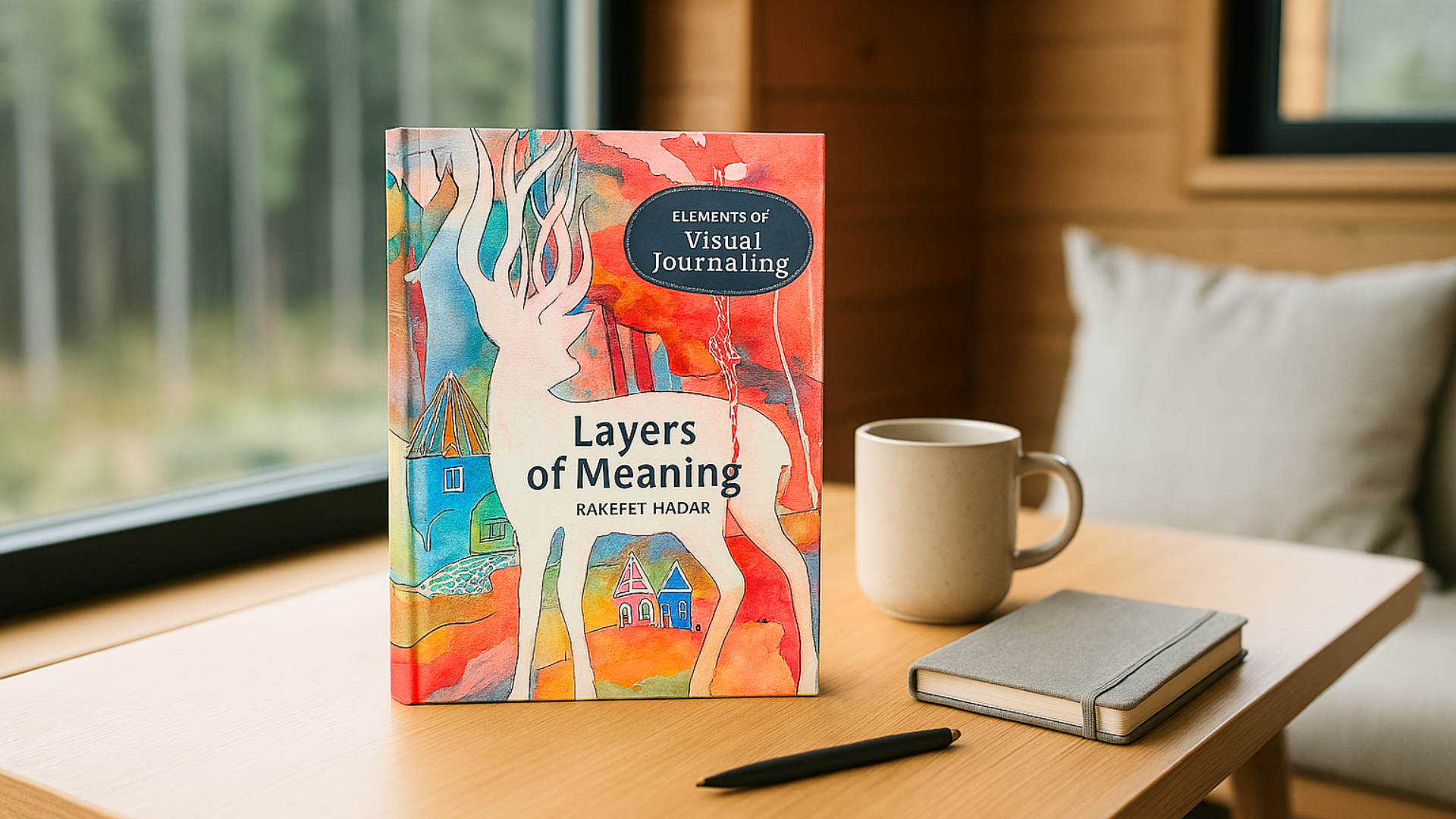Reconnecting with Yourself Through Visual Journaling

Book Review: Layers of Meaning by Rakefet Hadar
A reflective guide for using intuitive visual journaling as a path to emotional insight
In Layers of Meaning, Rakefet Hadar offers more than an introduction to art journaling. She presents a compassionate, emotionally grounded process for reconnecting with creativity in everyday life. Rooted in her background as an expressive arts therapist, Hadar’s seven-step method of intuitive journaling helps readers move through overwhelm, emotional stagnation, and internal disconnection using accessible materials and gentle self-inquiry. This is not a book about performance or aesthetics. It is about tuning in, noticing, and allowing expression to emerge layer by layer.
What the book promises
Layers of Meaning invites readers into the practice of intuitive visual journaling, where art becomes a tool for emotional expression, clarity, and healing. Rakefet Hadar, an expressive arts therapist and founder of the Intuitive Journaling method, presents a creative process that is both accessible and deeply personal. The book promises a structured yet gentle approach for those looking to reconnect with themselves through creativity, especially during times of overwhelm or transition.
This is not a book about artistic technique. It is a book about emotional exploration through image, colour, texture, and movement. Hadar emphasizes that no art background is necessary. Her invitation is to those who feel drawn to creative self-expression but may not know how to begin.
What the book delivers
Hadar delivers on her promise through a clear and compassionate presentation of her seven-step “Layers of Meaning” process. These steps guide readers through grounding, visualization, spontaneous creation, and integration. Each one is accompanied by reflective questions and gentle prompts. The framework encourages emotional safety and intuitive flow, making it easy to follow without being rigid.
Throughout the book, Hadar shares stories from her life and from her students, many of whom found visual journaling during times of grief, burnout, or emotional change. These stories help readers see how this work unfolds in real life. The tone is never prescriptive. Instead, it offers space for curiosity and experimentation.
One of the most compelling aspects of the book is its visual content. Photographs of journal pages, in all their layered, imperfect beauty, give a sense of what intuitive journaling can look like. They remind the reader that this is not about making something beautiful, but about expressing something true.
Style and structure
The writing is warm and grounded. Hadar’s tone is thoughtful and welcoming, with a rhythm that invites pause and reflection. She avoids jargon and keeps her language simple and sincere. There is a calm confidence in her voice that will reassure beginners and gently encourage those who may feel intimidated by creative work.
The book’s structure mirrors its content. It is layered, with each chapter building on the last while also standing on its own. Headings, prompts, and visual anchors make it easy to navigate. Readers can move through it sequentially or dip into chapters as needed.
The design also supports accessibility. Pages feel open, with enough white space to breathe. Visual examples are integrated throughout and serve to illustrate rather than impress. The overall effect is one of invitation, not instruction.
Where the book shines
Hadar excels at creating a safe, non-judgmental space for emotional exploration. She understands that for many people, especially women who carry emotional and creative blocks, getting started is the hardest part. Her gentle encouragement to begin with one small gesture or colour choice feels manageable, even for those in low-capacity states.
Her insights about layering—both in art and in emotional process—are especially powerful. By guiding readers to work in stages, she models a compassionate way of building insight over time. She also touches on the importance of witnessing, both self-witnessing and group reflection, which offers a valuable alternative to critique or evaluation.
The inclusion of short reflections from workshop participants adds depth. These voices illustrate how the practice works across a range of emotional experiences and personalities. They also show that intuitive journaling is not only a solitary practice, but one that can build connection and community.
Light limitations
The book assumes a certain openness to visual expression, which may feel unfamiliar to readers who tend to think in words or who are new to art journaling. While Hadar does a good job of welcoming all readers, some may wish for more detailed guidance on adapting the practices to different comfort levels or modalities.
A few references to materials and techniques may feel slightly aspirational for readers without access to mixed media tools. However, Hadar consistently reminds readers to use what they have, and the spirit of the book is rooted in resourcefulness.
This is not a workbook in the traditional sense. Readers looking for rigid structure or productivity outcomes may not connect with its more intuitive flow. That said, those who value reflective depth will likely find the pace and tone deeply nourishing.
Final thoughts
Layers of Meaning is a quiet, steady companion for anyone seeking to reconnect with their emotional life through creativity. Rakefet Hadar offers a process that is gentle but not superficial. Her approach is built on the belief that art can help us hear ourselves more clearly and hold what we find with compassion.
This is not a book about producing outcomes or achieving mastery. It is a book about process, presence, and trust. For women in particular, who may be navigating invisible labour, emotional overwhelm, or creative burnout, this book provides an invitation to return to themselves through colour, texture, and intuitive play.
Hadar reminds us that we do not have to wait for clarity before beginning. We can begin, and clarity can unfold. That message, delivered with care and honesty, makes this book a valuable and affirming guide.
Highly recommended for women seeking a gentle, creative way to process emotions, especially during times of stress, transition, or inner change, through the accessible and intuitive practice of visual journaling.